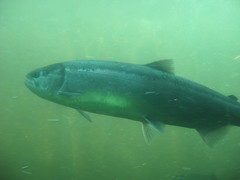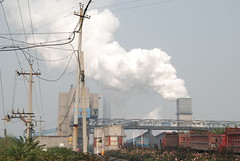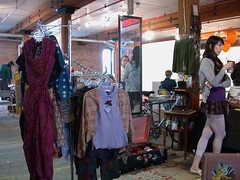 Image via Wikipedia
Image via Wikipedia
Towards Creating a New Economy by Stuart Price
For the purposes of analysis, "the economy" can be simplistically divided into 2 segments: that which creates economic activity of wealth and the opportunity for taxation; and that which is felt to diminish wealth and spend taxation. An example of the former is making luxury cars. Examples of the latter are caring for the elderly, healthcare in general and tackling global warming.
At the root of this division is another concept; that of values. Buying a nice shiny new BMW has high value, bestowing prestige and a sense of being marked out as special. High wages are given to those involved in manufacture, service and sales. High wages (or indebtedness) are needed to buy one and maintain the tax, insurance and fuel duty.
Caring for disadvantaged people on the other hand is felt to have low value, low prestige, low wages. Public services go to great length to avoid paying for it at all, taking and making every opportunity to offload the cost onto someone else; ultimately the poor themselves.
Politicians devise ever more sophisticated reasons to persuade us that they can actually reduce the "burden" of having to pay for this at all. The net result is that those who need social care or work within the sector grow progressively poorer, more oppressed and disadvantaged, while the economic infrastructure surrounding oil-based motor transport grows ever wealthier, or if in recession, deemed more worthy of protection and safeguarding.
When one adds to the equation that of the environmental damage caused by oil-based motor transport, and its association with global warming, the underlying factors become quite clear. While an immediate cessation of current transport practices is the sensible and urgent requirement to protect the planet from long-term catastrophe, the simple issue that continues to prevent this from happening is the financial self-interest of all the economic activity involved; international oil interests, manufacturing, associated infrastructure etc.., not to mention the vast numbers of people who drive to work or the supermarket and the army of individuals and organisations who service the whole thing; insurance, retailers, civil servants etc.. Most importantly, and a sizeable segment of the overall economy, is the entire industry devoted to persuading, and profiting from the belief that to acquire these passports to the good life we need to become indebted.
The underlying assumptions characterising some things as high value that we have to do, and other things as low value that we can't afford to do, are completely arbitrary; the product merely of habit.
Another situation involving a division of values is war (huge sums of money to be made from armaments) vs peace (peace activists are traditionally put down as idealistic lefty loonies, or worse "unpatriotic"). To complete the set of the "Four Horsemen of the Apocalypse" to Death and War we could add Famine (there are dire predictions for this) and Pestilence; vast numbers of people, often children, are daily dying for the sake of a few pence to buy needed drugs.
It is no coincidence that the same global institutions are involved; Oil, Armaments, Pharmaceuticals, Agribusiness and their hangers-on. It is also no coincidence that the associated rich are growing richer at an accelerating rate while the poor are growing poorer.
Current policies to tackle these issues concentrate on the symptoms rather than the cause; assuming, and this is debatable, that the will to tackle such issues exists as more than lip service. The cause is the nature of the economy itself and the way that high value is attached to some things and not others.
A recent UK news item discussed the way that a cancer sufferer was denied helpful drugs because they cost too much. The threshold cost for allowed use was put at £30K a year. This sum is an approximate annual average wage. The symbolic significance is clear; a system which contributes to taking life is affordable, saving life is not.
I recall many years ago a poster in my girlfriend's kitchen, reading "Wouldn't it be great if our schools had all the resources they required, while the air force had to hold a jumble sale to buy a new bomber." Such sentiments are not too fanciful, in an insane era which demands that the economy needs a new airport runway, while the consequences are damaging the entire planet. All economic activity is defined by the values we attach to things. The same global infrastructure which employs millions in the service of war, debt, oil, fertilisers and junk food, could equally be based around the core requirements of healing, goodwill, peace, reverence for all life and plenty.
It only needs one thing; our individual agreement. Take a look around you. Just how many things are going on that are damaging people, the world, the natural environment? How many of these are justified in the name of profit and making money? Just supposing we decided that having a rainforest in existence was actually more important and of greater long-term value than the money that could be made from chopping it down and creating a desert?
Recent events have shown just how fragile the economy is, being based at core, on the ludicrous notion of the profitability of being in debt. Recent events have also shown the nature of the establishment response; insisting that the system must be preserved at all costs and using our money to prop the system up; incidentally further indebting us all. The truth is that, from originally being merely a token of exchange, money and the supply of money has become a new route to making money, which in the end enslaves us all. The economy has disappeared up its own back passage and is surprised to find that there is a bad smell there!
The current historical era finds us with 2 linked situations. On the one hand the interlocking systems of the world economy are falling to pieces; a domino effect in which it is quite feasible to envisage that shares in some enterprises, luxury cars for instance, could become literally worthless. In addition, there is a growing awareness that in truth, buying a new car in order to bring happiness and contentment is a doomed enterprise to which we have been brainwashed by the prophets of profit.
Happiness and contentment are states of mind; not dependent on things. If the principle of a successful economy is matching supply and demand, then that demand, based on enduring values, is evident.
We have reached a critical juncture in the life of the planet. Either we will change, or we will destroy the world. Peace, healing the environment, feeding the hungry, healthy renewable energy sources, living as free, conscious ethical beings.. are not just fanciful pipe dreams but urgent requirements. If we attach high value to these, and other issues, then we will have created the basis for a new economic system.
ps. My own view, as far as motor cars go, is that BMWs are cool machines.
Please check out my website, Inspirit Me, for further articles, links and resources:
http://www.inspirit.me.uk
 Image by Mikko Itälahti via Flickr
Image by Mikko Itälahti via Flickr![Reblog this post [with Zemanta]](http://img.zemanta.com/reblog_e.png?x-id=74411915-6fc3-43dd-96a4-5305b8d4a7cd)

![Reblog this post [with Zemanta]](http://img.zemanta.com/reblog_e.png?x-id=3c4be92e-06ad-4684-9568-d55854c3c319)

![Reblog this post [with Zemanta]](http://img.zemanta.com/reblog_e.png?x-id=6b07152c-21dd-4ce7-8698-6f503ab271bc)

![Reblog this post [with Zemanta]](http://img.zemanta.com/reblog_e.png?x-id=4de72e05-df76-4e27-b5f7-86d8465c4834)

![Reblog this post [with Zemanta]](http://img.zemanta.com/reblog_e.png?x-id=b0d25ed9-d227-4429-8ad0-29bebba804a4)

![Reblog this post [with Zemanta]](http://img.zemanta.com/reblog_e.png?x-id=3965a311-cb80-4d69-bffe-1b0d9e94d43d)

![Reblog this post [with Zemanta]](http://img.zemanta.com/reblog_e.png?x-id=eb3cc16a-998f-4a9e-a3e2-b009beb3bb75)

![Reblog this post [with Zemanta]](http://img.zemanta.com/reblog_e.png?x-id=511757a3-e3c2-43e4-a6f9-7a17f49405eb)

![Reblog this post [with Zemanta]](http://img.zemanta.com/reblog_e.png?x-id=91ff62ec-9802-4e92-b6d3-d67ec8335255)

![Reblog this post [with Zemanta]](http://img.zemanta.com/reblog_e.png?x-id=62dd7377-d144-42f2-b6e4-dc74fe75c114)

![Reblog this post [with Zemanta]](http://img.zemanta.com/reblog_e.png?x-id=f83a5fd0-5081-4579-8ad8-eb7c9cb6e48d)

![Reblog this post [with Zemanta]](http://img.zemanta.com/reblog_e.png?x-id=cebd7612-98ec-43a5-85c5-4c484a992544)

![Reblog this post [with Zemanta]](http://img.zemanta.com/reblog_e.png?x-id=d66d75d9-9967-4c09-9660-20e07a4be5e0)

![Reblog this post [with Zemanta]](http://img.zemanta.com/reblog_e.png?x-id=adb7ac54-f46b-459c-83fd-831d2acdc379)

![Reblog this post [with Zemanta]](http://img.zemanta.com/reblog_e.png?x-id=82201e50-48f5-42ef-8cb1-835c18ee4054)

![Reblog this post [with Zemanta]](http://img.zemanta.com/reblog_e.png?x-id=e517cca2-e1bf-4a1f-b774-891257b72ea4)

![Reblog this post [with Zemanta]](http://img.zemanta.com/reblog_e.png?x-id=391ad90b-0794-402c-bd00-c4f72d47cbd5)

![Reblog this post [with Zemanta]](http://img.zemanta.com/reblog_e.png?x-id=69f5b2fa-ec7e-406d-9c2b-a0b1f90868bf)

![Reblog this post [with Zemanta]](http://img.zemanta.com/reblog_e.png?x-id=147c473f-dd2a-4e1f-9f3d-0e121f85fe05)